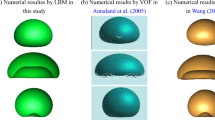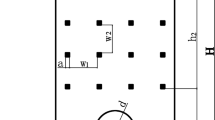Abstract
For the growth and departure of bubbles from an orifice, a free energy lattice Boltzmann model is adopted to deal with this complex multiphase flow phenomenon. A virtual layer is set at the boundary of the flow domain to deal with the no-slip boundary condition. Effects of the viscosity, surface tension, gas inertial force and buoyancy on the characteristics of bubbles when they grow and departure from an orifice in quiescent liquid are studied. The releasing period and departure diameter of the bubble are influenced by the residual gas at the orifice, and the interaction between bubbles is taken into consideration. The relations between the releasing period or departure diameter and the gravity acceleration show fair agreements with previous numerical and theoretical results. And the influence of the gas outflow velocity on bubble formation is discussed as well. For the bubbles growing in cross-flow field, effects of the cross-flow speed and the gas outflow velocity on the bubble formation are discussed, which is related to the application in ship resistance reduction. And optimal choice of the ship speed and gas outflow velocity is studied. Cases in this paper also prove that this high density ratio LBM model has its flexibility and effectiveness on multiphase flow simulations.
Similar content being viewed by others
References
Alizadeh, M., Seyyedi, S.M., Taeibi Rahni, M. and Ganji, D.D., 2017. Three-dimensional numerical simulation of rising bubbles in the presence of cylindrical obstacles using lattice Boltzmann method, Journal of Molecular Liquids, 236, 151–161.
Cahn, J.W., Elliott, C.M. and Novick-Cohen, A., 1996. The Cahn-Hilliard equation with a concentration dependent mobility: motion by minus the Laplacian of the mean curvature, European Journal of Applied Mathematics, 7(3), 287–301.
Chen, G.Q., Huang, X., Zhang, A.M. and Wang, S.P., 2019a. Simulation of three-dimensional bubble formation and interaction using the high-density-ratio lattice Boltzmann method, Physics of Fluids, 31(2), 027102.
Chen, G.Q., Huang, X., Zhang, A.M., Wang, S.P. and Li, T., 2019b. Three-dimensional simulation of a rising bubble in the presence of spherical obstacles by the immersed boundary-lattice Boltzmann method, Physics of Fluids, 31(9), 097104.
Chen, S.Y., Martz, D. and Mei, R.W., 1996. On boundary conditions in lattice Boltzmann methods, Physics of Fluids, 8(9), 2527–2536.
Cheng, H., Zhang, A.M. and Ming, F.R., 2017. Study on coupled dynamics of ship and flooding water based on experimental and SPH methods, Physics of Fluids, 29(10), 107101.
Cheng, M., Hua, J.S. and Lou, J., 2010. Simulation of bubble-bubble interaction using a lattice Boltzmann method, Computers & Fluids, 39(2), 260–270.
Fritz, W., 1935. Maximum volume of vapor bubbles, Physikalische Zeitschrift, 36, 379–384.
Guo, Z.L., Zheng, C.G. and Shi, B.C., 2002. Discrete lattice effects on the forcing term in the lattice Boltzmann method, Physical Review E, 65, 046308.
He, X.Y. and Luo, L.S., 1997. Lattice boltzmann model for the incompressible Navier-Stokes equation, Journal of Statistical Physics, 88(3–4), 927–944.
Hepworth, N.J., Boyd, J.W.R., Hammond, J.R.M. and Varley, J., 2003. Modelling the effect of liquid motion on bubble nucleation during beer dispense, Chemical Engineering Science, 58(17), 4071–4084.
Islam, M.T., Ganesan, P.B., Sahu, J.N. and Sandaran, S.C., 2015. Effect of orifice size and bond number on bubble formation characteristics: a CFD study, The Canadian Society for Chemical Engineering, 93(10), 1869–1879.
Jacqmin, D., 1999. Calculation of two-phase Navier-Stokes flows using phase-field modeling, Journal of Computational Physics, 155(1), 96–127.
Jamialahmadi, M., Zehtaban, M.R., MSteinhagen, H., Sarrafi, A. and Smith, J.M., 2001. Study of bubble formation under constant flow conditions, Chemical Engineering Research and Design, 79(5), 523–532.
Kendon, V.M., Cates, M.E., Pagonabarraga, I., Desplat, J.C. and Bladon, P., 2001. Inertial effects in three-dimensional spinodal decomposition of a symmetric binary fluid mixture: A lattice Boltzmann study, Journal of Fluid Mechanics, 440, 147–203.
Lee, T. and Lin, C.L., 2003. Pressure evolution lattice-Boltzmannequation method for two-phase flow with phase change, Physical Review E, 67, 056703.
Li, S., Han, R. and Zhang, A.M., 2016. Nonlinear interaction between a gas bubble and a suspended sphere, Journal of Fluids and Structures, 65, 333–354.
Li, S., Zhang, A.M., Han, R. and Liu, Y.Q., 2017. Experimental and numerical study on bubble-sphere interaction near a rigid wall, Physics of Fluids, 29(9), 092102.
Malenkov, I.G., 1971. Detachment frequency as a function of size for vapor bubbles, Journal of Engineering Physics, 20(6), 704–708.
Nourgaliev, R.R., Dinh, T.N., Theofanous, T.G. and Joseph, D., 2003. The lattice Boltzmann equation method: Theoretical interpretation, numerics and implications, International Journal of Multiphase Flow, 29(1), 117–169.
Rowlinson, J.S. and Widom, B., 1989. Molecular Theory of Capillarity, Clarendon Press, New York, USA.
Sun, T., Li, W.Z. and Yang, S., 2013. Numerical simulation of bubble growth and departure during flow boiling period by lattice Boltzmann method, International Journal of Heat and Fluid Flow, 44, 120–129.
Sunder, S. and Tomar, G., 2013. Numerical simulations of bubble formation from submerged needles under non-uniform direct current electric field, Physics of Fluids, 25(10), 102104.
Takada, N., Misawa, M., Tomiyama, A. and Hosokawa, S., 2001. Simulation of bubble motion under gravity by lattice Boltzmann method, Journal of Nuclear Science and Technology, 38(5), 330–341.
Wang, Z.K., Shi, D.Y. and Zhang, A.M., 2015. Three-dimensional lattice Boltzmann simulation of bubble behavior in a flap-induced shear flow, Computers & Fluids, 123, 44–53.
Wei, W.R., Xu, W.L., Deng, J., Tian, Z. and Zhang, F.X., 2018. Analysis on link between the macroscopic and microscopic air-water properties in self-aerated flows, China Ocean Engineering, 32(5), 614–623.
Wu, W.B., Liu, Y.L. and Zhang, A.M., 2017. Numerical investigation of 3D bubble growth and detachment, Ocean Engineering, 138, 86–104.
Yang, Z.L., Dinh, T.N., Nourgaliev, R.R. and Sehgal, B.R., 2001. Numerical investigation of bubble growth and detachment by the lattice- Boltzmann method, International Journal of Heat and Mass Transfer, 44(1), 195–206.
Zhang, A.M. and Liu, Y.L., 2015. Improved three-dimensional bubble dynamics model based on boundary element method, Journal of Computational Physics, 294, 208–223.
Zhang, A.M., Cui, P., Cui, J. and Wang, Q.X., 2015a. Experimental study on bubble dynamics subject to buoyancy, Journal of Fluid Mechanics, 776, 137–160.
Zhang, A.M., Sun, P.N. and Ming, F.R., 2015b. An SPH modeling of bubble rising and coalescing in three dimensions, Computer Methods in Applied Mechanics and Engineering, 294, 189–209.
Zhang, W.X. and Tan, R.B.H., 2003. A model for bubble formation and wee** at a submerged orifice with liquid cross-flow, Chemical Engineering Science, 58(2), 287–295.
Zheng, H.W., Shu, C. and Chew, Y.T., 2006. A lattice Boltzmann model for multiphase flows with large density ratio, Journal of Computational Physics, 218(1), 353–371.
Zhu, Z.F., Fang, S.L., Wang, X.Y., Meng, Z.W., Liu, P.X. and Du, X.M., 2011. Numerical simulation of viscous cavitating flow around a ship propeller, China Ocean Engineering, 25(3), 539–548.
Zuber, N., 1963. Nucleate boiling. The region of isolated bubbles and the similarity with natural convection, International Journal of Heat and Mass Transfer, 6(1), 53–78.
Acknowledgments
The authors would like to express their sincere thanks to Prof. ZHANG A-man from Harbin Engineering University for his valuable comments and suggestions on the manuscript, and Dr. WANG Zhi-kai from Harbin Engineering University for his discussion on the programming.
Author information
Authors and Affiliations
Additional information
Foundation item: This work was financially supported by the National Key R&D Program of China (Grant No. 2018YFC0308900), the Industrial Technology Development Program (Grant No. JCKY2018604C010) and Shenzhen Special Fund for Future Industries (Grant No. JCYJ20160331163751413).
Rights and permissions
About this article
Cite this article
Chen, Gq., Huang, X., Wang, Sp. et al. Study on the Bubble Growth and Departure with A Lattice Boltzmann Method. China Ocean Eng 34, 69–79 (2020). https://doi.org/10.1007/s13344-020-0007-7
Received:
Revised:
Accepted:
Published:
Issue Date:
DOI: https://doi.org/10.1007/s13344-020-0007-7




